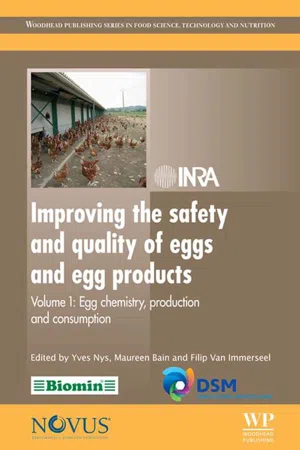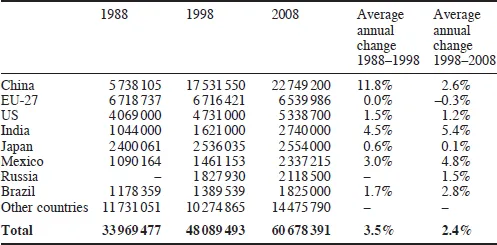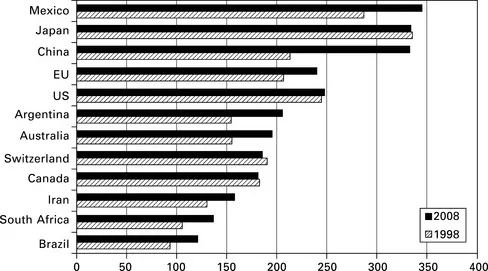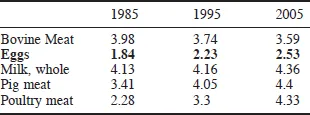Abstract:
World egg production and consumption have been increasing for the last ten years whereas egg production in the EU has remained stable in volume. EU production systems, however, have evolved dramatically in relation to consumer expectations regarding animal welfare and the variety of products and also due to the implementation of the EU welfare regulation. The situation remains contrasting within the EU. European egg consumption amounts to 240 eggs per person per year, with strong variations among countries, and a rise in the share of egg products in global consumption. Various steering factors will determine the future of the European egg industry, such as European regulation (animal welfare, environment, sanitary requirements), feedstuff price volatility, changes in consumers' preferences and finally the conclusions of World Trade Organization (WTO) negotiations, which could lead to an opening of the European market to products (egg powder for example) from emerging countries.
1.1 Introduction
World egg production has shown strong development for the last 20 years and has, along with poultry meat production, registered the most important growth in the coverage needs of protein for the world population. This chapter will begin by discussing world egg production before presenting its dynamics for past 20 years, with some particular analysis of the main producing countries (the US and China). Trade changes such as trends in global consumption for table eggs and egg products will be analysed. The chapter will then go on to present an overview of the European egg industry, focusing on the main producing countries and on the European regulation concerning animal welfare and its impact on production and market segmentations within the European Union. The diversity of the national situations will be analysed in relation to specific national rules and contexts.
The chapter will conclude by presenting the international production costs of selected countries. It will also present their future prospects in the global and the European markets in relation to different scenarios concerning international and European policies and regulations, global and European growth and demand in egg and egg products.
1.2 Worldwide overview
1.2.1 World production
According to the FAO, world egg production reached 60.7 Mt in 2008 (i.e. 1140 billion eggs; Table 1.1). China is by far the largest producer with 22.7 Mt, i.e. 37% of the world production, followed by the EU-27 and the US. World egg production rose on average by 2.4% per year during the ten last years, compared with a 3.5% growth during the previous decade, 1987–1997. Most of the world's growth originates from traditional Asian producing countries, which represent 59% of world production and are responsible for 70% of the world growth during the last ten years.
Table 1.1
World egg production (tonnes)
(source: FAO March 2010)
China is the main egg-producing country in the world and has shown strong development over the past 20 years, although production has slowed somewhat in the last few years. Ten Chinese provinces produced 80% of the national egg production in 2006 (vs. 70% 20 years ago). The Shandong and Hebei provinces represent a third of the Chinese production. Apart from a few areas which have large industrialized farms, Chinese farms are often little family production units, with the majority of their output going to family or local markets. A billion farms keep less than 200 hens each and produce only 10% of the Chinese production, whereas a few big farms keep (or integrate) more than a million billion hens each. Less than 5% of Chinese egg production was processed towards egg products in 2002. After a strong rise, the avian flu epidemic has slowed down the development of egg consumption since 2005-2006. Chinese egg consumption reached 333 eggs per capita in 2008 (source IEC, 2010).
The United States of America ranks in third place behind China and the EU-27. For the last ten years, US production has been more dynamic than its European counterpart (+ 1.2% a year, vs. stability in the EU). American farm sizes are also quite different from those in Europe, and very concentrated: in 2008, 255 farms kept 95% of the total 284 millions hens. Six major companies kept one-third of total livestock. According to Hans Windhorst, (2010a) the composition of the ten leading states in egg production has not changed very much for the last ten years, but the spatial pattern has changed a great deal. In 2008, Iowa ranked first with 16% of the US production, followed by Ohio (8%), Indiana (7.2%) and Pennsylvania (6.9%). Egg consumption was very high in the 1950s, around 380-400 eggs per capita but there followed a long decline until consumption reached 235 eggs per capita in 1995. For the last ten years, however, consumption has again increased and reached 248 eggs in 2008 (IEC, 2010).
1.2.2 World trade
According to FAO data, international trade reached 1.4 Mt for shell eggs, 55 000 t for egg powder and 218 000 t for liquid egg products in 2007, i.e. approximately 1.94 Mt of shell egg equivalent, intra-EU trade included. This accounts for only 3% of the global production. Nevertheless, international trade has increased during the last ten years by about 5% per year (6% per year for egg powder). Most of the trade for shell eggs and liquid egg products is within the EU. Three European countries rank in the top five exporting countries. The main shell egg exporting countries were, in 2008, the Netherlands (24% of the global trade), China (8%) and Spain (7%), followed by the US and Germany. The main importing countries were Germany (21%), followed by the Netherlands and France (12% each). The main exporting countries for liquid eggs trade were the Netherlands (40%) and France (13%).
The egg powder trade, after a strong development, has been stable for the past three years. The EU (12 400 t exported in 2007) and the US (11 300 t) are the leading exporters in this market, followed by India (7 700 t).
1.2.3 Consumption
The average consumption level in the world was assessed by the FAO to be 9.1 kg per person in 2005, which is to say about 145 eggs (Fig. 1.1). Strong variations exist according to different countries, however. For example, more than 300 eggs per capita were consumed in Japan and Mexico, 230–240 eggs in the EU and the US, and fewer than 100 eggs in most African countries and South East Asia. In developing countries, demand and supply should continue to grow more rapidly than in developed countries, due to a strong demographic growth in the former and to the already high consumption levels in most developed countries (Windhorst, 2008).
Fig. 1.1 Egg consumption levels in selected countries (egg/head 1998–2008). (source: IEC)
According to the FAO, eggs (together with poultry meat) have registered the most important growth in the coverage of protein needs for the world population in the past 20 years (Table 1.2). The high level of egg consumption in Asia can be partly explained by a low level of milk consumption. Indeed, although, on average, egg protein supply/milk protein supply ratios are around 0.6 for the world, this figure varies greatly from more than 2 in most Asian countries (5 in Korea, 3 in Thailand, 2.7 in China, 1.7 in Japan) to less than 1 in Europe and America (1.1 in Canada, 0.9 in France, 0.5 in Germany and 0.4 in the US).
Table 1.2
Protein supply quantity (g/capita/day) (g)
(source: FAO March 2010)



